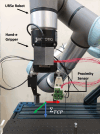A multi-modal sensing system for human-robot interaction through tactile and proximity data
- PMID: 40556838
- PMCID: PMC12186202
- DOI: 10.3389/frobt.2025.1581154
A multi-modal sensing system for human-robot interaction through tactile and proximity data
Abstract
Introduction: The rapid advancement of collaborative robotics has driven significant interest in Human-Robot Interaction (HRI), particularly in scenarios where robots work alongside humans. This paper considers tasks where a human operator teaches the robot an operation that is then performed autonomously.
Methods: A multi-modal approach employing tactile fingers and proximity sensors is proposed, where tactile fingers serve as an interface, while proximity sensors enable end-effector movements through contactless interactions and collision avoidance algorithms. In addition, the system is modular to make it adaptable to different tasks.
Results: Demonstrative tests show the effectiveness of the proposed system and algorithms. The results illustrate how the tactile and proximity sensors can be used separately or in a combined way to achieve human-robot collaboration.
Discussion: The paper demonstrates the use of the proposed system for tasks involving the manipulation of electrical wires. Further studies will investigate how it behaves with object of different shapes and in more complex tasks.
Keywords: human-robot collaboration; human-robot interaction; modular; multi-modal; proximity sensor; tactile sensor.
Copyright © 2025 Laudante, Mirto, Pennacchio and Pirozzi.
Conflict of interest statement
The authors declare that the research was conducted in the absence of any commercial or financial relationships that could be construed as a potential conflict of interest.
Figures















References
-
- Caccavale R., Finzi A., Laudante G., Natale C., Pirozzi S., Villani L. (2023). Manipulation of boltlike fasteners through fingertip tactile perception in robotic assembly. IEEE/ASME Trans. Mechatronics 29, 820–831. 10.1109/TMECH.2023.3320519 - DOI
-
- Chandrasekaran B., Conrad J. M. (2015). “Human-robot collaboration: a survey,” in SoutheastCon 2015, 1–8. 10.1109/SECON.2015.7132964 - DOI
-
- Cichosz C., Gurocak H. (2022). “Collision avoidance in human-cobot work cell using proximity sensors and modified bug algorithm,” in 2022 10th international conference on control, mechatronics and automation (ICCMA), 53–59. 10.1109/ICCMA56665.2022.10011601 - DOI
-
- Cirillo A., Laudante G., Pirozzi S. (2021b). Proximity sensor for thin wire recognition and manipulation. Machines 9, 188. 10.3390/machines9090188 - DOI
LinkOut - more resources
Full Text Sources

